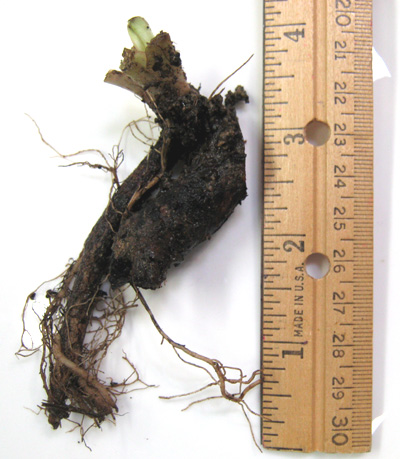Live Comfrey
Root for Planting
3
Types of Comfrey (Boraginaceae family, Symphytum Genus)
There
are 35 species of Symphytum. I sell 1 type of Common/True Comfrey, 1 type of 'Blue'
Comfrey, and 2 types of Russian Comfrey. Prices
& How to Order

 |
Common
or True Comfrey
Symphytum officinale
Common,
True or Quaker comfrey is botanically known as "Symphytum
officinale". It is a perennial native to Europe. It is 3 feet tall
including the flower stalk.
It has been used medicinally for thousands of years by many different cultures.
Young leaves are eaten in Europe.
Flowers are cream, creamy yellow, white, magenta, pink or purplish. I sell
the ones with purple flowers.
Some sources call this "cultivated" comfrey while other sources
call Russian comfrey the same thing.
This photo is the flowerstalk with seeds on it.
|
 |
It can
be somewhat invasive by spreading viable seeds. The roots are not invasive.
True
Comfrey seeds germinate quickly, especially on wet soil that
is peat or loam. Stratifying the seeds helps germination. Stratification
is a cold, moist period. It needs to be stratified for about 1-3 months.
You can do this easily in a refrigerator.
It can also be propagated by root cuttings.
It is used as a green manure or fertilizer. It produces less biomass than
Russian Comfrey. Biomass is the amount of living matter in a given area.
|
|



|
Russian
Comfrey
Symphytum x uplandicum=
Symphytum peregrinum=
Symphytum asperum x officinale
Cultivated
or Russian Comfrey is botanically known as "Symphytum × uplandicum"
or "Symphytum x uplandica". It is a natural cross between common
comfrey and rough comfrey. It grows to 4 feet tall including the flowerstalk.
There are different varieties such as Bocking #4 and Bocking #14.
I
sell Bocking #4. It is used in farming and as a fodder
(feed) plant for animals. It has deeper roots than #14 so is more drought
resistant. Though both cultivars are drought resistant.
I
sell Bocking #14. It is used more as a garden fertilizer
by making compost tea (liquid fertilizer). And it is used by putting the
leaves in a compost pile or in a hole when planting potatoes, trees or other
plants. Poultry and livestock love it as much as they do Comfrey #4.
For more about the differences between Bocking No. 4 and No. 14: Russian
Comfrey Cultivars.
The 2 types of Russian comfrey are very similar and can be used interchangeably.
Livestock eat both Comfrey #4 and #14. Both can be used for compost and
fertilizer.
Russian comfrey has purple, white, magenta-pink, red or blue (that fade
to pink) flowers. The seeds are not viable. It has to be reproduced by root
and crown cuttings.
It produces 100-120 tons per acre of biomass per year. This is 3 times the
amount that True Comfrey produces.
Black and white photo:
"This acre of Stephenson Strain (No. 14) Symphytum Peregrinum in its second cutting season, just before a ten ton cut on a Devon Farm (England), is how a field crop should look.
Mr. J.C. Quicke, whose plants are not yet fully established, secured over 2 1/2 times the yield of the 1944 Hannah Dairy Research Trial in 1954, one of the coldest summers on record.
It is a perennial like lucerne (alfalfa), but lasting 20 years, and like lucerne, only those who know how to grow it get a good crop."
-Report on Quaker Comfrey (Symphytum Peregrinum), Number One, The 1954 Research Results by Lawrence D. Hills.
Published 1955 by The Henry Doubleday Research Association, Bocking, Braintree, Essex, England.
|
|

 |
Symphytum Hidcote Blue
Hidcote Blue has pretty blue flowers. It is invasive by the roots. The leaves grow
to 1 to 1½ feet tall. The flower stalk adds another ½ foot.
It is shorter than both True Comfrey and Russian Comfrey.
It sometimes produces seeds that are viable but not usually. It can be propagated
by cutting up the root.
It is also called Symphytum grandiflorum Hidcote Blue. |
|
 |
Many
Names for Comfrey
Other
common names for all types of comfrey are asses-ears, backwort, blackwort,
boneset, borraja, bruisewort, bourrache, buyuk, consolida, consoude, consound,
consuelda, cumfrey, gewone smeerworte, gum plant, healing herb, knitbone,
knitback, liane chique, wallwort, consound, slippery root and yalluc.
Bees love comfrey flowers.
|
 |
Grow
Comfrey (Comfry) from Roots or Seeds
The seeds
of Russian Comfrey will not produce seedlings. The seeds are sterile. So
it is propagated by root and crown cuttings (offsets). This sterility is
an advantage if you do not want your plants to be invasive.
True/Common Comfrey can be propagated by root cuttings or by planting seeds.
The roots can be planted any time of the year that the ground is not frozen.
|

|
Buy Live
Comfrey Roots for Planting
Grow
your own Comfrey: True/Common Comfrey, Russian Bocking #4, Russian Bocking
#14, Symphytum Hidcote Blue.
Your order includes a flyer about how to take care of your plants.
Comfrey
Easy Order Page
|
| |
|










